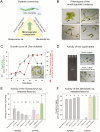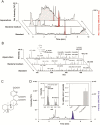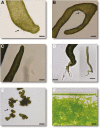Macroalgal-bacterial interactions: identification and role of thallusin in morphogenesis of the seaweed Ulva (Chlorophyta)
- PMID: 32016363
- PMCID: PMC7289720
- DOI: 10.1093/jxb/eraa066
Macroalgal-bacterial interactions: identification and role of thallusin in morphogenesis of the seaweed Ulva (Chlorophyta)
Abstract
Macroalgal microbiomes have core functions related to biofilm formation, growth, and morphogenesis of seaweeds. In particular, the growth and development of the sea lettuce Ulva spp. (Chlorophyta) depend on bacteria releasing morphogenetic compounds. Under axenic conditions, the macroalga Ulva mutabilis develops a callus-like phenotype with cell wall protrusions. However, co-culturing with Roseovarius sp. (MS2) and Maribacter sp. (MS6), which produce various stimulatory chemical mediators, completely recovers morphogenesis. This ecological reconstruction forms a tripartite community which can be further studied for its role in cross-kingdom interactions. Hence, our study sought to identify algal growth- and morphogenesis-promoting factors (AGMPFs) capable of phenocopying the activity of Maribacter spp. We performed bioassay-guided solid-phase extraction in water samples collected from U. mutabilis aquaculture systems. We uncovered novel ecophysiological functions of thallusin, a sesquiterpenoid morphogen, identified for the first time in algal aquaculture. Thallusin, released by Maribacter sp., induced rhizoid and cell wall formation at a concentration of 11 pmol l-1. We demonstrated that gametes acquired the iron complex of thallusin, thereby linking morphogenetic processes with intracellular iron homeostasis. Understanding macroalgae-bacteria interactions permits further elucidation of the evolution of multicellularity and cellular differentiation, and development of new applications in microbiome-mediated aquaculture systems.
Keywords: Algal growth; cell wall; cross-kingdom interaction; morphogenesis; morphogenesis-promoting factor; phytohormone; rhizoid; seaweed; siderophore.
© The Author(s) 2020. Published by Oxford University Press on behalf of the Society for Experimental Biology.
Figures




Similar articles
-
Thallusin Quantification in Marine Bacteria and Algae Cultures.Mar Drugs. 2022 Nov 1;20(11):690. doi: 10.3390/md20110690. Mar Drugs. 2022. PMID: 36355014 Free PMC article.
-
From model organism to application: Bacteria-induced growth and development of the green seaweed Ulva and the potential of microbe leveraging in algal aquaculture.Semin Cell Dev Biol. 2023 Jan 30;134:69-78. doi: 10.1016/j.semcdb.2022.04.007. Epub 2022 Apr 19. Semin Cell Dev Biol. 2023. PMID: 35459546 Review.
-
Time Course Exo-Metabolomic Profiling in the Green Marine Macroalga Ulva (Chlorophyta) for Identification of Growth Phase-Dependent Biomarkers.Mar Drugs. 2017 Jan 10;15(1):14. doi: 10.3390/md15010014. Mar Drugs. 2017. PMID: 28075408 Free PMC article.
-
Macroalgal-bacterial interactions: Role of dimethylsulfoniopropionate in microbial gardening by Ulva (Chlorophyta).Mol Ecol. 2018 Apr;27(8):1808-1819. doi: 10.1111/mec.14472. Epub 2018 Feb 7. Mol Ecol. 2018. PMID: 29290092
-
Exploring bacteria-induced growth and morphogenesis in the green macroalga order Ulvales (Chlorophyta).Front Plant Sci. 2015 Mar 3;6:86. doi: 10.3389/fpls.2015.00086. eCollection 2015. Front Plant Sci. 2015. PMID: 25784916 Free PMC article. Review.
Cited by
-
Current knowledge of the Southern Hemisphere marine microbiome in eukaryotic hosts and the Strait of Magellan surface microbiome project.PeerJ. 2023 Oct 3;11:e15978. doi: 10.7717/peerj.15978. eCollection 2023. PeerJ. 2023. PMID: 37810788 Free PMC article. Review.
-
Exploring Seaweed-Associated Marine Microbes: Growth Impacts and Enzymatic Potential for Sustainable Resource Utilization.Indian J Microbiol. 2024 Jun;64(2):593-602. doi: 10.1007/s12088-024-01205-w. Epub 2024 Mar 3. Indian J Microbiol. 2024. PMID: 39011007 Free PMC article.
-
Thallusin Quantification in Marine Bacteria and Algae Cultures.Mar Drugs. 2022 Nov 1;20(11):690. doi: 10.3390/md20110690. Mar Drugs. 2022. PMID: 36355014 Free PMC article.
-
Easy Removal of Epiphytic Bacteria on Ulva (Ulvophyceae, Chlorophyta) by Vortex with Silica Sands.Microorganisms. 2022 Feb 21;10(2):476. doi: 10.3390/microorganisms10020476. Microorganisms. 2022. PMID: 35208930 Free PMC article.
-
A new glance at the chemosphere of macroalgal-bacterial interactions: In situ profiling of metabolites in symbiosis by mass spectrometry.Beilstein J Org Chem. 2021 May 19;17:1313-1322. doi: 10.3762/bjoc.17.91. eCollection 2021. Beilstein J Org Chem. 2021. PMID: 34136011 Free PMC article.
References
-
- Amin SA, Hmelo LR, van Tol HM, et al. . 2015. Interaction and signalling between a cosmopolitan phytoplankton and associated bacteria. Nature 522, 98–101. - PubMed
-
- Blomster J, Bäck S, Fewer DP, Kiirikki M, Lehvo A, Maggs CA, Stanhope MJ. 2002. Novel morphology in Enteromorpha (Ulvophyceae) forming green tides. American Journal of Botany 89, 1756–1763. - PubMed
-
- Butler A. 1998. Acquisition and utilization of transition metal ions by marine organisms. Science 281, 207–210. - PubMed
-
- Califano G, Wichard T. 2018. Preparation of axenic cultures in Ulva (Chlorophyta). In: Charrier B, Wichard T, Reddy C, eds. Protocols for macroalgae research. Boca Raton, FL: CRC Press, 159–173.
Publication types
MeSH terms
Substances
LinkOut - more resources
Full Text Sources
Miscellaneous

